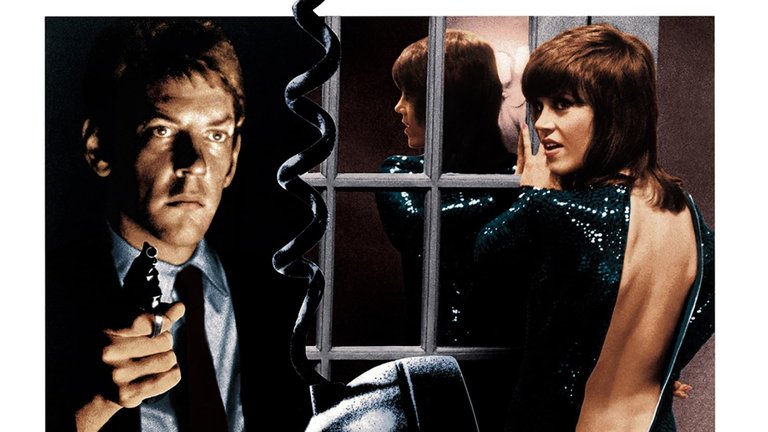Film Review: Klute (1971)

For cinephiles prone to nostalgia, New Hollywood remains an untouchable zenith—a brief, fertile period when studio constraints loosened, auteurs flourished, and American cinema grappled with societal decay in ways both radical and artistically daring. Yet while this era birthed masterpieces that redefined filmic language (The Godfather, Chinatown), it also produced works whose cultural specificity now feels alienating. These relics of New Hollywood’s excesses—steeped in the anxieties of the Vietnam-Watergate era—often prioritise mood over narrative cohesion, ambiguity over catharsis. Klute, Alan J. Pakula’s 1971 psychological thriller, exemplifies this duality. Hailed upon release as a groundbreaking fusion of neo-noir and feminist character study, it remains a fascinating yet frustrating artefact—a film whose hypnotic atmosphere and career-defining performances clash with pacing and structural choices that test modern patience.
The plot, deceptively straightforward, begins with the disappearance of Pennsylvania chemical company executive Tom Gruneman. When conventional investigations stall, his colleague Peter Cable (Charles Cioffi) enlists private detective John Klute (Donald Sutherland)—a stoic, crisply suited former policeman—to trace Gruneman’s last movements in New York. The sole lead? An obscene letter addressed to Bree Daniels (Jane Fonda), a call girl and aspiring actress. Klute’s pursuit of Bree—initially met with hostility—unfolds against a backdrop of menace: anonymous, threatening phone calls, the suspicious death of a fellow call girl, and Bree’s fractured memories of a violent client. As Klute insinuates himself into her life, their relationship evolves from adversarial to protective, then veers into a tentative romance. Yet the central mystery—Gruneman’s fate, the stalker’s identity—functions less as narrative engine than as a catalyst for exploring Bree’s psyche.
Klute’s commercial success—it ranked among 1971’s top 20 films—owed much to Fonda’s stratospheric fame. Fresh from Barbarella (1968) and They Shoot Horses, Don’t They? (1969), she embodied both countercultural chic and mainstream appeal. The film’s anti-establishment veneer—corporate corruption lurking beneath Gruneman’s disappearance—tapped into post-Altamont disillusionment. Audiences thrilled to the notion of “sticking it to the Man,” even if the plot ultimately sidesteps systemic critique. Critics, meanwhile, celebrated its genre-blurring ambition: a gritty character study masquerading as a thriller, shot through with neo-noir fatalism. Equally revolutionary was its unflinching, non-judgmental portrayal of prostitution—a stark departure from the moralising tropes that dominated pre-1968 Hollywood. Here, Pakula leveraged newfound creative freedoms not for exploitation, but for empathy.
Fonda’s Oscar-winning performance remains the film’s lodestar. Immersing herself in Method preparation—she shadowed New York call girls, documenting their routines and defences—she crafted a Bree both fiercely autonomous and achingly vulnerable. In therapy sessions (a narrative device that prefigures The Sopranos), Bree confesses to relishing the “power” prostitution affords: the illusion of control in transactional encounters, the ability to compartmentalise intimacy. Yet Fonda layers this bravado with fragility—a woman armouring herself against a world that reduces her to body parts. Critics often cite Bree as a feminist icon, but Fonda resists easy heroism, exposing the contradictions of a woman dealing with liberation and exploitation in equal measure.
If Fonda’s role demanded volcanic emotionality, Sutherland’s required tectonic restraint. Known for countercultural roles (MASH, Kelly’s Heroes), he subverts expectations as Klute—a man so buttoned-down he seems allergic to spontaneity. With his regulation haircut and funereal suits, Klute embodies institutional propriety, yet Sutherland hints at fissures beneath the façade: a flicker of discomfort when Bree mocks his squareness, a barely perceptible softening as their bond deepens. It’s a masterclass in reactive acting, his stillness amplifying Fonda’s volatility. That the script leaves Klute’s inner life opaque—even during their obligatory romantic entanglement—speaks less to narrative neglect than to Pakula’s interest in Bree’s subjectivity. Klute exists primarily as a mirror, reflecting her fractured self-image.
In later decades, Klute became retroactively enmeshed with Pakula’s The Parallax View (1974) and All the President’s Men (1976) as a “paranoia trilogy” critiquing institutional rot. Yet this framing overstates Klute’s political ambitions. While surveillance motifs abound—Klute wiretaps Bree’s phone, a reel-to-reel recorder looms ominously—the film lacks the overt institutional critique of its successors. The villain, when revealed, is driven not by conspiratorial malice but personal pathology. Pakula’s focus remains resolutely intimate: not Watergate-era distrust, but the ways individuals surveil themselves—Bree’s therapist dissecting her choices.
What cements Klute’s New Hollywood credentials is its aesthetic audacity. Gordon Willis—later the cinematographer of The Godfather—bathes the film in inky shadows, his infamous “Prince of Darkness” palette rendering even daylight scenes clammy and claustrophobic. Key moments unfold in near-darkness: Bree’s apartment, a labyrinth of half-lit corridors; the climactic confrontation, shot so obscurely that audiences strain to parse the action. This visual murkiness mirrors Bree’s psychological disorientation, but risks alienating viewers accustomed to thriller conventions. Equally divisive is the pacing: scenes linger past narrative necessity, luxuriating in uncomfortable silences. Michael Small’s minimalist score—jangling piano notes, ambient street noise—heightens the unease but denies cathartic release. The result is less a thriller than a tone poem, its rhythms closer to Antonioni than Hitchcock.
For all its virtues, Klute stumbles as a genre exercise. The mystery’s resolution feels both predictable and underwhelming—a third-act twist that telegraphs its punches. Pakula’s prioritisation of mood over plot mechanics leaves narrative threads dangling: What of Gruneman’s corporate dealings? The socio-economic forces pushing women into Bree’s profession? Such elisions reflect New Hollywood’s auteurist excesses—the belief that ambiguity equates to depth.
Klute works not as a taut thriller, but as a riveting character portrait—a snapshot of New Hollywood’s ambitions and blind spots. Fonda’s searing performance and Willis’s chiaroscuro brilliance compensate for meandering pacing and narrative anticlimax. Yet the film’s true legacy lies in its refusal to conform—to genre expectations, to simplistic morality, to the myth of the “happy hooker.” For contemporary viewers, it demands a recalibration of expectations: not a puzzle to be solved, but a psyche to be navigated, shadows and all. Whether this languid, stubbornly opaque vision still mesmerises or merely exasperates depends on one’s appetite for New Hollywood’s brand of uneasy, unsparing truth-telling.
RATING: 6/10 (++)
Blog in Croatian https://draxblog.com
Blog in English https://draxreview.wordpress.com/
InLeo blog https://inleo.io/@drax.leo
Hiveonboard: https://hiveonboard.com?ref=drax
InLeo: https://inleo.io/signup?referral=drax.leo
Rising Star game: https://www.risingstargame.com?referrer=drax
1Inch: https://1inch.exchange/#/r/0x83823d8CCB74F828148258BB4457642124b1328e
BTC donations: 1EWxiMiP6iiG9rger3NuUSd6HByaxQWafG
ETH donations: 0xB305F144323b99e6f8b1d66f5D7DE78B498C32A7
BCH donations: qpvxw0jax79lhmvlgcldkzpqanf03r9cjv8y6gtmk9